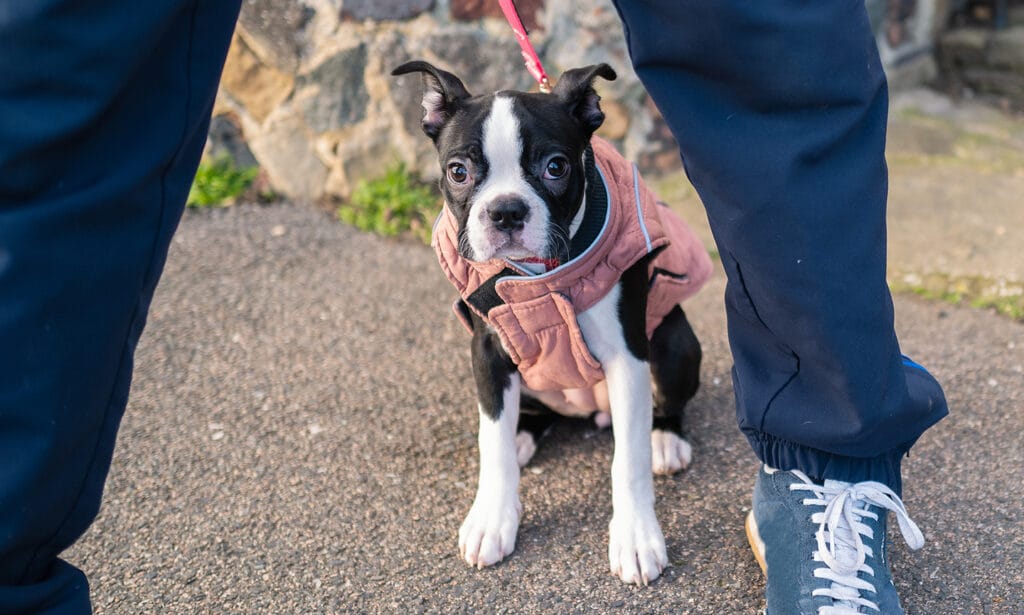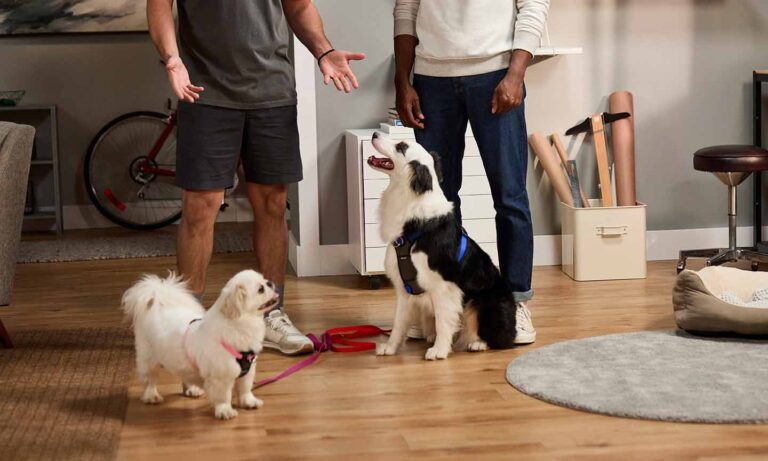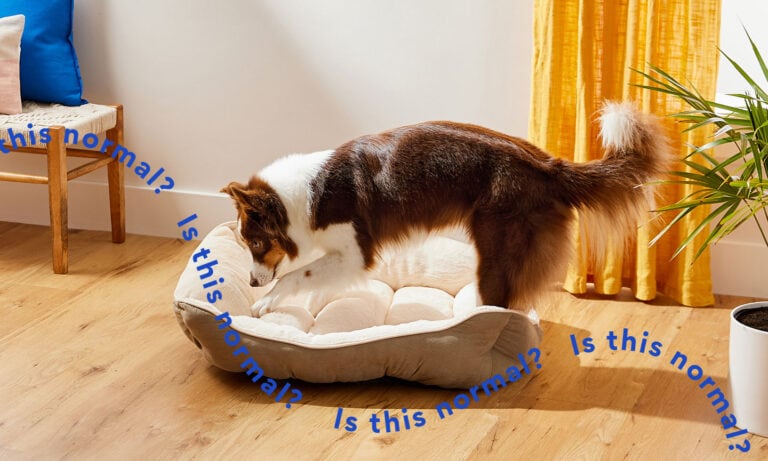Just like people, dogs have different personalities. Some are outgoing and playful, and love to be around other dogs and people, while others may be a bit more reserved. These reserved dogs are shy and act more like wallflowers, observing the action instead of partaking in it.
Shyness and reservation aren’t necessarily traits that need to be fixed. Sometimes they’re innate characteristics, and your dog is perfectly happy sitting on the sidelines or curled up in their bed at home. But in some cases, that shyness stems from fear, anxiety and/or a lack of confidence. In those cases, there are some things you can do to help your reserved dog gain confidence.
In This Guide:
What Is a Shy or Reserved Dog?
A shy or reserved dog is one who typically doesn’t seek out interaction with other dogs or people. They may be uncomfortable in new situations, and move close to their owners or back away from any action.
Leslie Sinn, DVM, DACVB, CPDT-KA, veterinary behaviorist and founder of Behavior Solutions in Ashburn, Virginia, says to think of them as a wallflower: They're happy to sit back and watch what’s going on, but don’t necessarily want to join the middle of the party. You can identify a shy dog by how willing they are to approach and engage people and other dogs.
A dog’s personality may change depending on the situation, though. Their actions are often driven by a sense of caution or unease in unfamiliar situations, or with unfamiliar people, says Dr. Sinn. That means a shy dog may be outgoing and playful with their family, but more reserved when they’re around strangers.
What Does a Shy or Reserved Dog Look Like?
One of the biggest signs of shyness in a dog is moving away from the action and/or closer to their human when they’re in an uncomfortable situation, Dr. Sinn says.
Other signs include:
- Hesitation: They don’t like to approach new situations.
- Reduced activity: They might freeze or show minimal exploration in unfamiliar settings or places they’re exposed to for the first time.
- Avoidance: They might avoid eye contact and likely won’t be eager to approach new people.
- Hiding: They might seek shelter under furniture or behind their human.
- Less vocal: Unlike their more outgoing furry friends, shy dogs tend to be quieter, taking in the scene instead of calling attention to themselves.
- Yawning or lip licking: This can have a calming, self-soothing effect.
Submissive body language is another indicator that your dog may be shy, according to Dr. Sinn. More examples are:
- Low or tucked tail
- Ears back
- Showing their belly
- Crouching
- Stiffness
Why Are Some Dogs Shy or Reserved?
From genetics to situational factors, several things can contribute to shy or reserved behavior in dogs. It’s important to remember that not every dog is outgoing and full of energy. Some dogs don’t need to be part of the action, says Shir Limazati, ABCDT, CPDT-KA, CFFP, certified dog trainer and owner of Another Chance Training in Chicago.
That being said, understanding the underlying reasons for a dog’s shy behavior, and giving them the right support, can help them feel more comfortable.
Here are the primary reasons for shyness:
Genetics
Just like people, dogs inherit traits from their parents. Temperament can be influenced by genetics, and some breeds are naturally more reserved or cautious.
Dr. Sinn says that ancient or primitive breeds, like Shiba Inus, Chow Chows and Akitas, tend to be among the shy dog breeds. Often, herding breeds like Border Collies may also appear shy, cautious and/or anxious.
Unlike Golden Retrievers and Labradors, Basenjis aren’t usually social butterflies and may come across as shy, although it’s more just that they’re independent. Karelian Bear Dogs, which were originally bred for hunting and as guard dogs, are another independent breed that can appear reserved.
Lack of Socialization and Environment
Lack of socialization in puppy years can have a major impact on your dog’s behavior in adult years. Because of this, early life experiences are crucial.
Dogs who weren’t adequately socialized or had little human interaction during the critical period of puppyhood—typically the first three to four months—may be more shy around unfamiliar people, animals or situations. How much time they spent with their litter and having a limited circle—i.e., they were only exposed to a small group of people or animals—can contribute to shyness in groups or around strangers, Limazati says.
In other words, a scared puppy can turn into a dog who is scared of everything, so you want to make sure to set them up for success early.
Negative Experiences
If a dog has had negative experiences, such as abuse, neglect or a traumatic event—especially during their formative years—they may become shy or fearful as a defense mechanism.
Limazati says it’s possible that a puppy starts out outgoing and confident, but then a traumatic event completely changes their temperament, transforming them from outgoing to more reserved.
Learning and Observation
Dogs can pick up shy behaviors from observing the reactions of other dogs or people around them. If a dog sees another dog reacting fearfully to a situation, they might also learn to respond similarly, says Dr. Sinn.
Health Issues
Sometimes, what might seem like shyness could be linked to underlying health issues. For example, if your dog has difficulty seeing or hearing they may seem more reserved, because they can’t connect with their surroundings as well, according to Dr. Sinn.
If you suspect a health issue, make an appointment to see your veterinarian. This is especially important if you notice a change in your dog’s usual behavior. And, of course, always make sure to keep up with regular checkups and vaccinations.
How To Help Your Shy or Reserved Dog
Reserved dogs don’t necessarily need to be helped. Think of how some humans are introverts and others are extroverts. An introverted human is comfortable in their own space and doesn’t necessarily want to be pulled from that familiar environment. It’s the same way with dogs, says Dr. Sinn.
However, it’s different if a dog is exhibiting shyness or reservation out of fear. In these cases, you can help your dog gain confidence. Go at their pace, though, and take cues from your pup. Forcing a dog into uncomfortable situations can exacerbate the problem and make them retreat even more.
The goal is to obtain consent from your shy dog every step of the way and stick to a predictable routine. This will help them gain confidence, Limazati says.
Here are some practical tips for pet parents to help support their shy dogs:
Socialize Gradually
Again, you never want to force your dog into uncomfortable situations, but sometimes shyness stems from a lack of socialization. While you may not be able to completely turn things around, you can slowly introduce your dog to new people, animals and environments at their own pace.
This is called desensitization. It involves gradually exposing your dog to a situation that has previously triggered a fear response in the hopes that they’ll become less bothered and reactive over time.
Start with short interactions in less busy environments. Dr. Sinn recommends a small playdate with a doggy best friend or two, instead of a crowded dog park. See how your dog responds, and then you can slowly build up as they become more comfortable.
Make sure these are controlled situations where your dog can have successful, positive interactions. This might mean exposing them to a calm dog with a gentle demeanor, or having a friend who is familiar with shy dogs come over for a visit. Consider the size matchup too: You might not want to pair a shy Chihuahua with a Bullmastiff, for example.
Allow your dog to set the pace for interactions, and don’t put your own social preferences on the dog, says Dr. Sinn. We all have our quirks, just like dogs have their quirks. If the dog isn’t interested in interacting, dragging the dog toward another dog or shoving him in someone’s arms is not going to make the dog want to interact more. Instead, make it voluntary, allowing them to develop coping skills.
Be Patient and Calm
As mentioned, patience is key—but you also want to stay calm to model that behavior for your dog. Your dog can pick up emotional cues from you, so show them there's nothing to fear.
Understanding that every dog has their own emotions, and giving them time to come out of their shell at their own pace will also help create a stronger bond between you and your pup, according to Limazati.
If you start to get frustrated, take a break and try again at a different time.
Provide Regular Exercise and Mental Stimulation
Regular physical exercise and mental stimulation (like puzzle toys) can help reduce overall stress and anxiety in dogs, according to Dr. Sinn. Walk your dog regularly and provide an enriching environment at home.
Maintain a Regular Routine
Additionally, a predictable schedule helps reduce anxiety and builds confidence in shy dogs, says Limazati. Try to maintain a regular routine for feeding, walks and playtime. This can create a sense of comfort, since your dog knows what’s coming and when.
Give Them Positive Reinforcement
You want to stay away from punishment and negative reinforcement as much as possible when dealing with a shy dog. Instead, focus on positive reinforcement, which will foster overall confidence, Dr. Sinn says.
Use treats, praise and play to reward your dog when they show bravery or engage in social interactions. Make sure these rewards are highly motivating for your dog. The goal here is counter-conditioning—or pairing a situation that normally elicits a negative emotional response with something that triggers a positive response, like giving them a treat they love.
Be Consistent With Training
In addition to positive reinforcement, stay consistent with gentle training, which also helps build confidence. Training also lets your dog build problem-solving skills, which in turn will bolster their independence and their curiosity, says Limazati.
Be gentle though. Focus on basic commands and positive reinforcement; and avoid harsh corrections, which can make your dog even more timid.
Provide a Safe Space
Again, shyness isn’t necessarily something you have to correct in your dog. Don’t force them into interactions they don’t want to have, says Limazati. Instead, give them the opportunity to socialize in a way that feels comfortable to them, while allowing them to have a safe space.
Outdoors, this may mean giving them space to walk around so they can retreat if they feel uncomfortable. At home, make sure your dog has a safe, quiet place where they can go to decompress when they feel overwhelmed, like a crate or a quiet room.
Get Professional Training
If your dog’s shyness is severe or they don’t progress (or they regress), Dr. Sinn says you may want to consider consulting a professional dog trainer or a behaviorist.
They can offer more tailored advice and strategies that will help your dog feel more comfortable. Ideally, you want to find someone who has a lot of experience with shy dog training. You can also look for how-to videos on social media—just make sure the advice comes from a properly certified trainer.
Are Shyness and Anxiety in Dogs the Same Thing?
Shyness and anxiety can go hand-in-hand, and they often look similar. But they’re not the same thing.
Dr. Sinn says anxiety is the anticipation of something uncomfortable or bad happening—and it could be specific (like they don’t want something dropped on them) or generalized (they’re worried about the world and the environment in general).
Shyness is a personality trait, up there with introversion in people. Shy dogs have a low-key personality and need more time to connect and reach out comfortably. They’re easily overwhelmed by big groups, noise and busyness.
Shyness is seen more often in social situations, whereas anxiety may be more persistent. If you watch closely, there are distinct differences in a dog's body language that you may notice.
While a reserved dog or shy puppy may hang back or stick close to their owner, they don’t always exhibit signs of fear—but they might. An anxious, fearful dog almost always shows at least some of the following signs:
- Panting
- Pacing
- Trembling/shaking
- Drooling
- Hiding
- Withdrawing from their owner
- Barking
- Growling
- Low or tucked tail
- Ears pinned back
- Dilated pupils
Keep in mind that while shy dogs just may interact less due to lack of interest, it doesn’t mean they’re anxious. However, when pups are forced into uncomfortable situations, they may become nervous dogs, showing signs of anxiety as a manifestation of their discomfort, says Dr. Sinn.
Shyness is often an innate personality trait, and it’s not always associated with fear. If your dog is naturally shy or reserved, you don’t have to fix them—they’re likely happy just as they are. However, if you notice anxiousness, you may want to help your dog build confidence. Proper socialization and training them to follow basic commands is a good place to start.
Expert input provided by Leslie Sinn, DVM, DACVB, CPDT-KA, founder of Behavior Solutions in Ashburn, Virginia; and Shir Limazati, ABCDT, CPDT-KA, CFFP, owner of Another Chance Training in Chicago.
This content was medically reviewed by a veterinarian.
More about dog training:
Share:















